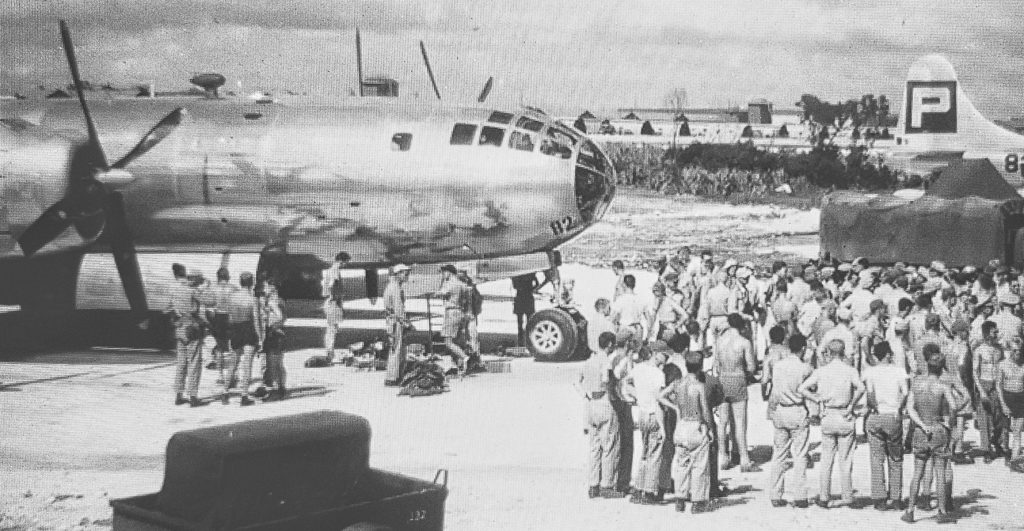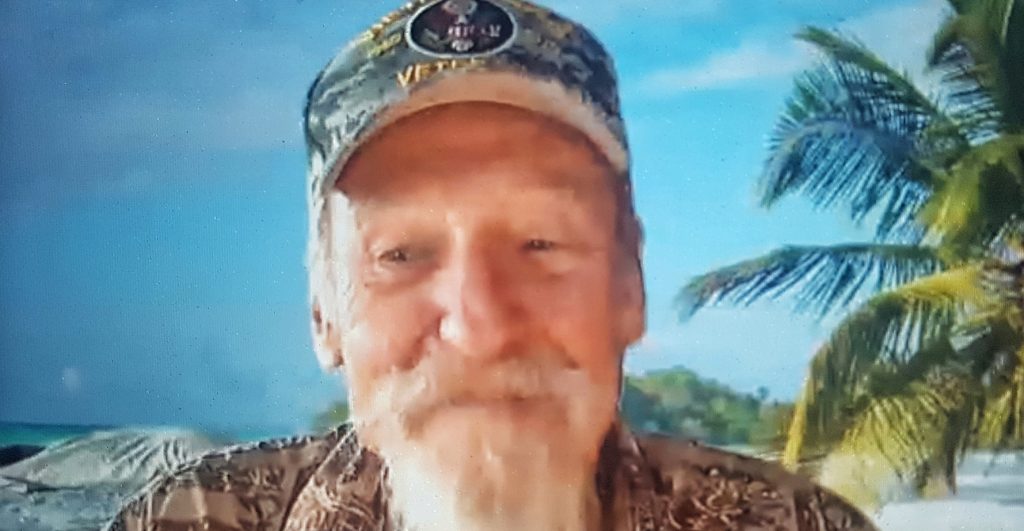‘Tinian and The Bomb’: A must read

The B29 plane that was named Enola Gay after Col. Paul Tibbets’ mother is seen here at the Tinian airport during World War II. (CONTRIBUTED PHOTOS)
It took Marianas historian and educator Don A. Farrell about 20 years to research, track down files, and go on a trip to the National Archives in Washington, D.C. to put together the story of his latest book, Tinian and The Bomb, which tells the story of how the United States detonated two nuclear bombs over Hiroshima and Nagasaki in Japan during World War II.
Farrell himself told the story of how he put together the intriguing pieces of the World War II puzzle during the history talks series of the Pacific Historic Parks last Tuesday. Readers of the book itself, Tinian and The Bomb should expect to read comprehensive information, insights and details about how the United States came up with the bombs. The book is an organized understanding of those unforgettable events in history and gives readers an enlightened perspective when they finish and put down the book.
“I received a message from the University of Guam in 1998, the year after I have left Guam and moved to Tinian. I was told there is a copy of the Tinian atomic bomb files in the National Archives in Washington, D.C. …I answered ‘There cannot be such a thing’ because nobody believed it existed,” Farrell said. “I was fortunate to receive a grant from the CNMI Humanities Council to go and find them…and they were there and I brought [copies of] them home. After years of translating, transcribing, and speaking to the people involved with the project, we were able to publish the book, Tinian and the Bomb which is a very unique story.”
Farrell starts the book answering why the United States got involved in the production of atomic bombs and, closer to home, Tinian’s role in the mission to denotate the bombs.
“German experimental physicist Otto Hahn in his studies accidentally broke in half an atom of uranium, not really knowing what had happened. He worked together with his colleagues and he discovered nuclear fusion. In the process of splitting the uranium atom in half, not only did he end up with two other equal parts but they also released large amount of energy in the form of neutrons that could split other uranium in the atom, leading into a nuclear reaction. Scientists saw all the opportunities that might be presented and one of them was, of course, creating inexpensive nuclear energy…an uncontrollable nuclear reaction which might end up creating an atomic bomb,” he said.
“Germany immediately began their atomic bomb project and many of the scientists that were working in Germany became quite frightened with Mr. Hitler and his attitude toward Jewish scientists, as he referred to physics as ‘Jewish science.’ They left Germany and Austria as those areas were being occupied by Hitler and moved to England, Canada, and the U.S. They knew what was happening in Germany and fearful in the event that, if Germans actually figured out how to make a bomb out of uranium, they would use it to their advantage to conquer the world.”

Tinian and The Bomb author and Tinian resident Don Farrell took 20 years to decode and transcribe the Tinian bomb files he retrieved from the National Archives in Washington, D.C.
Several of these scientists, including Dr. Leo Slizard, visited Albert Einstein who was in the United States, to convince him to sign a letter to President Franklin D. Roosevelt to warm him of the German science that was developing, “based on fear that if Hitler got it first, he would use it against the free world. …Word of his letter got out and more people urged the President to at least take a look at the problem of uranium and could it be developed into a bomb. …Although the United Stated was not involved during World War II, Roosevelt agreed that it was worth studying,” he said. “…A National Defense Center was created and it brought together America’s top scientists. …They first conducted actual nuclear reaction within the stadium of the University of Chicago and proved that nuclear reaction was possible and this could be developed into an atomic bomb and this information was bought to President Roosevelt. The Manhattan Project was established for research and development. …Factories were built in Tennessee for the refinement process. …Manufacturing was held in a huge facility in Hanford, Washington.”
By this time, the United States has already developed a long-range bomber called XB29. The concept of a four-engine long range bomber was actually developed in 1935 when America became concerned with the possibility of an invasion by a foreign force at their southern border with Mexico or northern borders with Canada. The war in the Pacific was also developing.
“Then came [the question;] where would we launch this bomb? …Finding a place where they can be used in the Pacific against Japan became the question. Adm. Ernest J. King was quite convinced that the capture of the Mariana Islands, particularly Saipan, Tinian, and Guam were key to the…war in the Pacific because, from the Marianas they can turn north and go directly toward Japan…,” Farrell said.
“…Tinian was obviously the right place for the atomic bomb project. Saipan only had one runway and it was overcrowded [and had] no more space for another group of B29 special group that was being trained for handling an atomic bomb. …The 6th naval construction brigade went to work—13,000 men, millions of tons of dynamite, hundreds of dump trucks and huge equipment began turning Tinian into the largest airbase in the world.”
Parts of the first atomic bomb, called Little Boy, was brought to Tinian aboard the USS Indianapolis from San Francisco. When it arrived on Tinian, discussions on the final days of the project ensued. “The bomb was completely assembled, taken to the loading pit, which was just a concrete hole in the ground, and loaded in the Enola Gay. …The mission to Hiroshima had seven planes involved—one plane flew to Iwo Jima…another plane, a C-54, left for Iwo Jima and with an atomic bomb loading crew to stand by if anything happened to Enola Gay along the way,” Farrell said.
“But Enola Gay went straight right to Hiroshima dropped the bomb on Aug. 6, 1945, at 9:02am Tokyo time and flew directly back to Tinian at 2:30pm. …The second mission, bombing Nagasaki, was done on Aug. 9, 1945,” he added.
Farrell recounted that there were many challenges along the way of writing his book, like decoding the Tinian bomb files. “There were copies of original messages that had been sent back and forth. …People everywhere talking about the atomic bomb project but I could not understand them because they were speaking in codes. I was very fortunate to get researchers and they were able to help me decode messages. I re-organized them by dates and names….” he said.
“I read many books and became concerned about the presentation because of the negative publicity during the Cold War. I finally sent a letter to my dad who landed in Iwo Jima and Okinawa and I asked, ‘What do you think about the bombs, Dad?’ He immediately replied, ‘Those damn bombs saved my life!’ …This is not a philosophical story, this is a war story and that what I decided to write over a period of 20 years.”
Tinian and The Bomb is available in hard copy and Kindle version on Amazon.com and in Bestseller along Middle Road.























